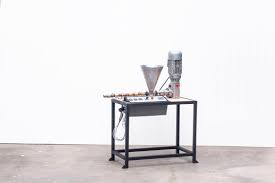Understanding the Precious Plastic Extrusion Machine: A Game Changer for Recycling and DIY Projects
The world of plastic recycling has come a long way, and one of the standout players in this space is the Precious Plastic extrusion machine. Designed to empower individuals and small businesses to recycle plastic waste, this innovative piece of equipment is helping create a more sustainable future, one plastic flake at a time. In this post, we’ll break down how the extrusion machine works, how it compares to other plastic processing tools like injection mold machines, and the challenges you might face if you’re considering using one.
What is the Precious Plastic Extrusion Machine?
The Precious Plastic extrusion machine is a simple, open-source tool that turns recycled plastic waste into usable material. It’s part of a larger initiative by Precious Plastic, a global community focused on making plastic recycling accessible and DIY-friendly. The extruder works by melting shredded plastic and forcing it through a heated barrel, then pushing it through the nozzle and often into a mold to form a new shape. This process is called “extrusion,” and it’s a core method for shaping plastic into various products.
You can use extruded plastic to create everything from lampshades to recycled plastic lumber. Essentially, the extruder helps turn what would otherwise be waste into something functional and creative. The best part? You don’t need to be a massive factory to make it happen. Small businesses, schools, and community groups can get involved in recycling plastics on a much smaller scale.
How Does the Extruder Work?
The process itself is fairly straightforward. First, you take plastic waste (like bottles, containers, or other clean, shredded plastic) and load it into the hopper of the extruder. Once the plastic enters the extruder barrel, an auger moves it toward the nozzle, and simultaneously the plastic gets heated to a specific temperature to melt it down. The heating is typically controlled by a set of thermostats, and the plastic is kept at the right viscosity for smooth extrusion.
The molten plastic is then forced through a nozzle or die in large volumes to form a shape. The temperature, pressure, and speed can all be adjusted depending on what type of product you want to create. The extruder is just a larger Filastruder that isn’t made for creating filament.
Extrusion vs. Injection Molding: What’s the Difference?
While both extrusion and injection molding are methods for heating and shaping plastic, they work in fundamentally different ways. Let’s take a quick look at how they differ, especially in the context of small-scale operations like the Precious Plastic extruder.
- Extrusion: In extrusion, plastic is melted and pushed through a die to create continuous shapes like lumber or rods. The process is continuous, meaning you can keep extruding material for as long as you have plastic flakes in the hopper. This makes it perfect for creating long, uniform products that can be cut to the desired length later.
- Injection Molding: On the other hand, injection molding involves melting plastic and injecting it into a mold cavity under high pressure. Once the plastic cools and solidifies, you remove the molded part. Injection molding is typically used for creating more complex, three-dimensional parts. It’s better designed for producing intricate details. However, it requires specific molds, which can be expensive and take time to produce.
For a small-scale operation, you want to think carefully before deciding what machine is the best purchase for the products that you want to create. You can learn more about injection mold machines here!
The Challenges of Using the Extruder
While the Precious Plastic extruder is a fantastic tool for small-scale plastic recycling, it does come with its share of challenges. Here are a few things to keep in mind:
- Plastic Quality: Not all plastics are created equal, and the extruder works best with certain types of plastic (like HDPE and PP). If you’re using mixed plastics or heavily contaminated plastic waste, you might run into issues like inconsistent melting or clogging. Sorting and cleaning plastic before feeding it into the machine is key to getting good results. DO NOT MIX MULTIPLE TYPES OF PLASTIC!!
- Learning Curve: While the machine itself is relatively simple to operate, getting consistent results can take some practice. You’ll need to monitor the temperature and pressure carefully to avoid overheating or under-melting the plastic. Experimentation is part of the process, so don’t be discouraged if things don’t work perfectly at first.
- Space and Maintenance: The machine is relatively compact compared to industrial extruders, but it still requires space to operate effectively. You’ll need a clean, ventilated area, and some basic maintenance to keep it running smoothly. Over time, parts like the heating elements or the nozzle may wear out and need to be replaced.
- Throughput Limitations: The small-scale extruder isn’t designed for mass production. If you’re looking to recycle plastic in large volumes, you might find the throughput slower compared to industrial machines. However, for small-scale operations, hobbyists, and community projects, it’s a fantastic tool.
Conclusion
The Precious Plastic extrusion machine is an excellent tool for those looking to get creative with plastic recycling. Whether you’re turning waste into useful products or experimenting with new designs, this machine empowers individuals and small businesses to take part in solving the global plastic problem. While there are challenges to consider, particularly around plastic quality and machine maintenance, the benefits far outweigh the drawbacks—especially when you consider the positive environmental impact of recycling and reusing plastic. If you’re ready to roll up your sleeves and dive into plastic recycling, the extruder could be the perfect addition to your workshop!

